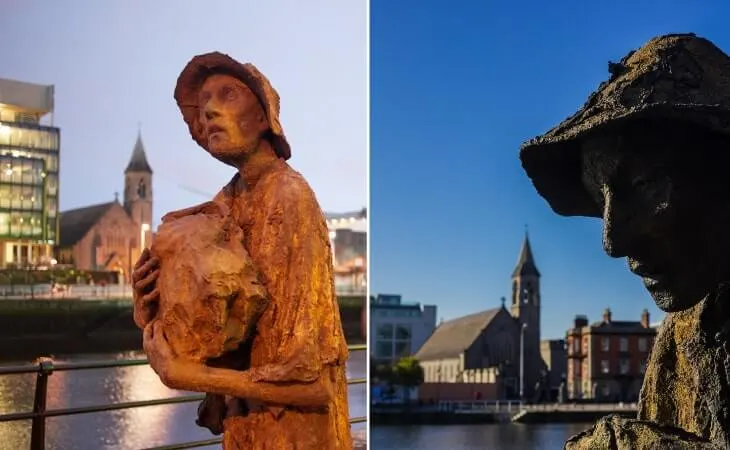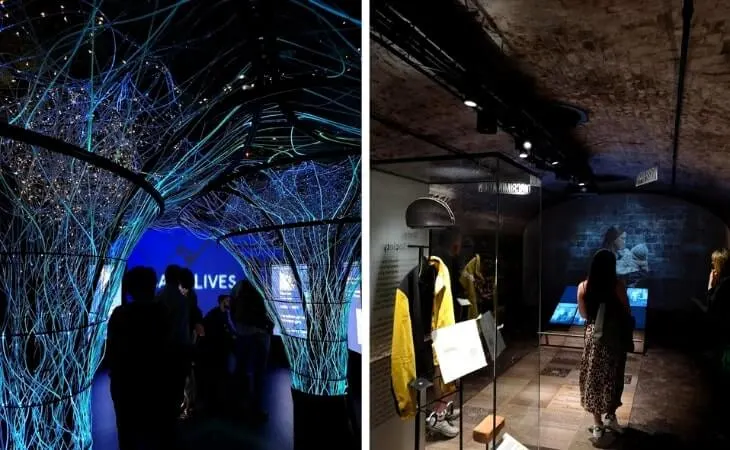The Jeanie Johnston is one of the most unique museums in Dublin.
The Jeanie Johnston was a ship built for carrying cargo across the Atlantic Ocean, but during the Irish Famine, it began carrying desperate passengers to America.
It’s described as a Coffin Ship; however, in 16 trans-Atlantic trips, nobody died, and a baby boy was even born on board.
In the guide below, you’ll discover everything from where to grab Jeanie Johnston tickets to what to expect from the tour.
Some quick need-to-knows about the Jeanie Johnston

Although a visit to the Jeanie Johnston Famine ship is fairly straightforward, there are a few need-to-knows that’ll make your visit that bit more enjoyable.
1. Location
The Jeanie Johnston ship of today is a replica Tall Ship, identical in every detail to the original. She retired to the Docklands in Dublin and is now run as a museum on Custom House Quay. It’s a 15-minute walk from the City Centre or 12 minutes on the number 151 bus.
2. Opening hours
The tours take place daily from 10:00 to 16:00 every half hour.
3. How long it takes
The tour lasts about 50 minutes, and a knowledgeable guide will take you through the stories of the people who had to flee Ireland during the Famine. You will find out about the conditions they had to endure and what awaited them when they finally arrived in America.
4. Part of the Dublin Pass
Exploring Dublin over 1 or 2 days? If you buy a Dublin Pass for €70 you can save from €23.50 to €62.50 on Dublin’s top attractions, like the EPIC Museum, the Guinness Storehouse, 14 Henrietta Street, the Jameson Distillery Bow St. and more (info here).
Things you’ll see, do and learn on the Jeanie Johnston tour
Those that climb aboard the Jeanie Johnston Famine ship are in for a treat, with a wealth of history to be discovered.
The tours offer an insight into the stories of those who were forced to leave Ireland, many forever, along with the ship itself.
1. Follow in the footsteps of those who fled the Famine

Photo by Mark Hewitt Photography (Shutterstock)
Desperation makes people courageous, and none more so than the Irish escaping the Great Hunger. The Jeanie Johnston tells their story as they left their homeland for a better life in America.
Step below decks to experience what it was like for 250 people crammed into a hold meant for 40 at most. They spent 23½ hours there every day, only emerging for a half hour to get some fresh air.
And this was a boat with a decent captain – thousands of people died on other ships. The lucky passengers were those who only had to endure seasickness, starvation, and storms.
2. Meet the passengers from the past

Photos via Shutterstock
The guides on the Jeanie Johnston tour are knowledgeable and often amusing, despite the sad stories. At least the Jeanie Johnston had one good news story, the birth of a baby boy named Nicholas Johnston Ryan.
The Donovan family from Tralee owned the ship, and most of the passengers were either tenants or former tenants availing of Poor Law legislation that allowed Donovan to pay their passage and claim it back later.
Win-Win for Mr Donovan as he also got the £3 10s for each fare, and the passengers thrived because he didn’t want his business to suffer because of any horror stories.
3. Experience a famine ship firsthand

Photos via Shutterstock
As they stepped aboard, the immigrants would have been awed by the grandeur of the Jeanie Johnston and its promise of a new life to come.
They wouldn’t have had long to admire their surroundings, though, as getting them packed into their quarters would have been immediate. How long would they have waited, excitement giving way to anxiety before the ship finally pulled anchor?
The seasickness started, and dignity disappeared. Thankfully, they had a doctor and 30 minutes daily to bring their blankets outside and shake them in the fresh air while their quarters were washed out. Nobody died, though.
4. Discover the story behind the original ship

Photo by Andrei Nekrassov (Shutterstock)
The Jeanie Johnston Famine ship was built in 1847 by a Canadian, John Munn. She was sold later that year to John Donovan & Sons, hardware merchants in Tralee. They had a large timber yard, and this figured in their purchasing decision.
Emigration up to this point had been sporadic, but by 1847 it was obvious that it would continue, so buying the ship was a sound business proposition. They could ship emigrants out and bring timber back.
Most of the passengers were from the Tralee area, so that was probably why they got such good care on the Jeanie Johnston – Donovan was protecting his local business.
Places to visit near the Jeanie Johnston ship
One of the beauties of the Jeanie Johnston is that it’s a short spin away from many of the best places to visit in Dublin.
Below, you’ll find a handful of things to see and do a stone’s throw from the Jeanie Johnston Famine ship (plus places to eat and where to grab a post-adventure pint!).
1. EPIC Museum (2-minute walk)

Photos by The Irish Road Trip
Epic by name and nature, you can spend hours here discovering the stories of our Irish diaspora at the EPIC Museum. Voted Europe’s best tourist attraction in 2019, 2020, and 2021, the museum is entirely interactive. Stamp your EPIC passport, dance a jig or reel, or test your knowledge with the EIPC quiz and loads more.
2. The Famine Memorial (3-minute walk)

Photos via Shutterstock
Norma Smurfit commissioned The Famine statues in 1997, and it is dedicated to the Irish who were forced to leave Ireland during the Famine. The sculpture’s location on Custom House Quay is fitting as the Perseverance, the first famine ship to leave Ireland, sailed from here on St Patrick’s Day 1846.
3. Trinity College (15-minute walk)

Photos via Shutterstock
The oldest university in Ireland, Trinity College, was founded by Queen Elizabeth I in 1592. Catholics were admitted in 1793, and it was 1904 before women were allowed to study there. The old library, which includes The Long Room, is the largest in Ireland, and it’s also home to the famous Book of Kells.
